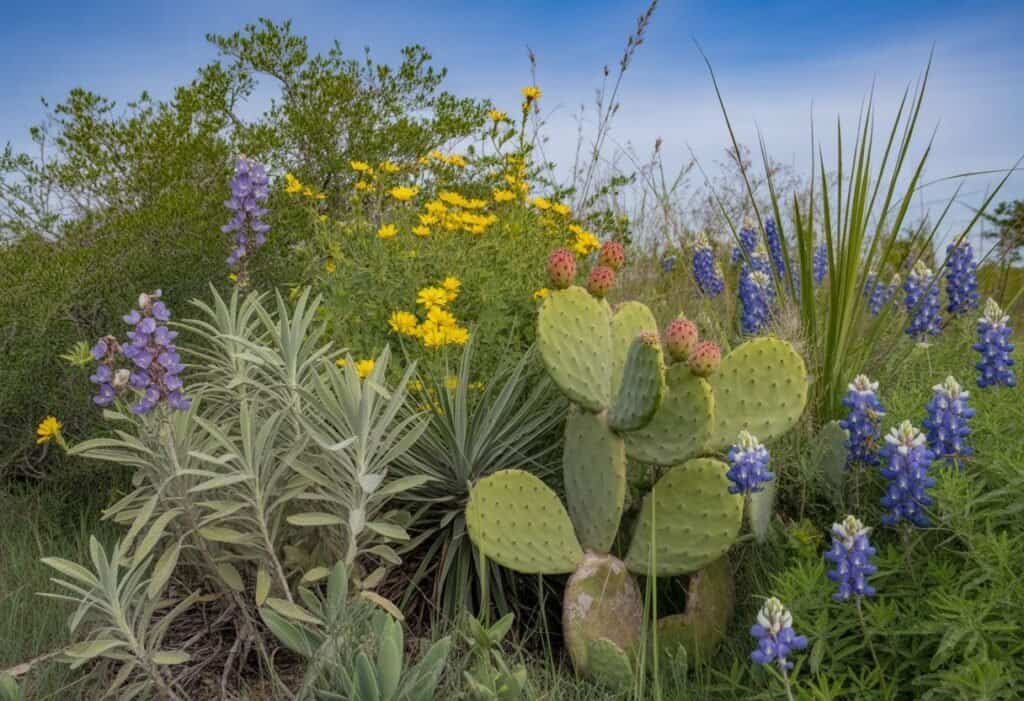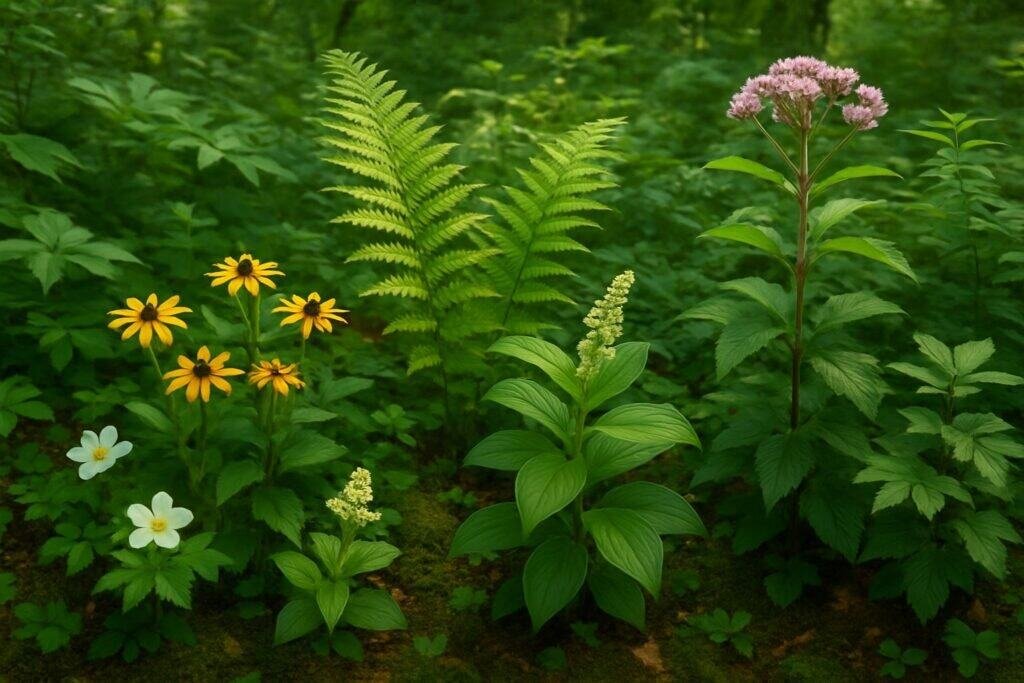Austin native plants bring beauty and resilience to local gardens while supporting our unique ecosystem. These plants have adapted to Central Texas’s challenging climate over thousands of years.
They thrive with minimal water and care once established. Choosing native plants for your Austin garden saves water, reduces maintenance, and creates habitat for local wildlife like butterflies, bees, and birds.
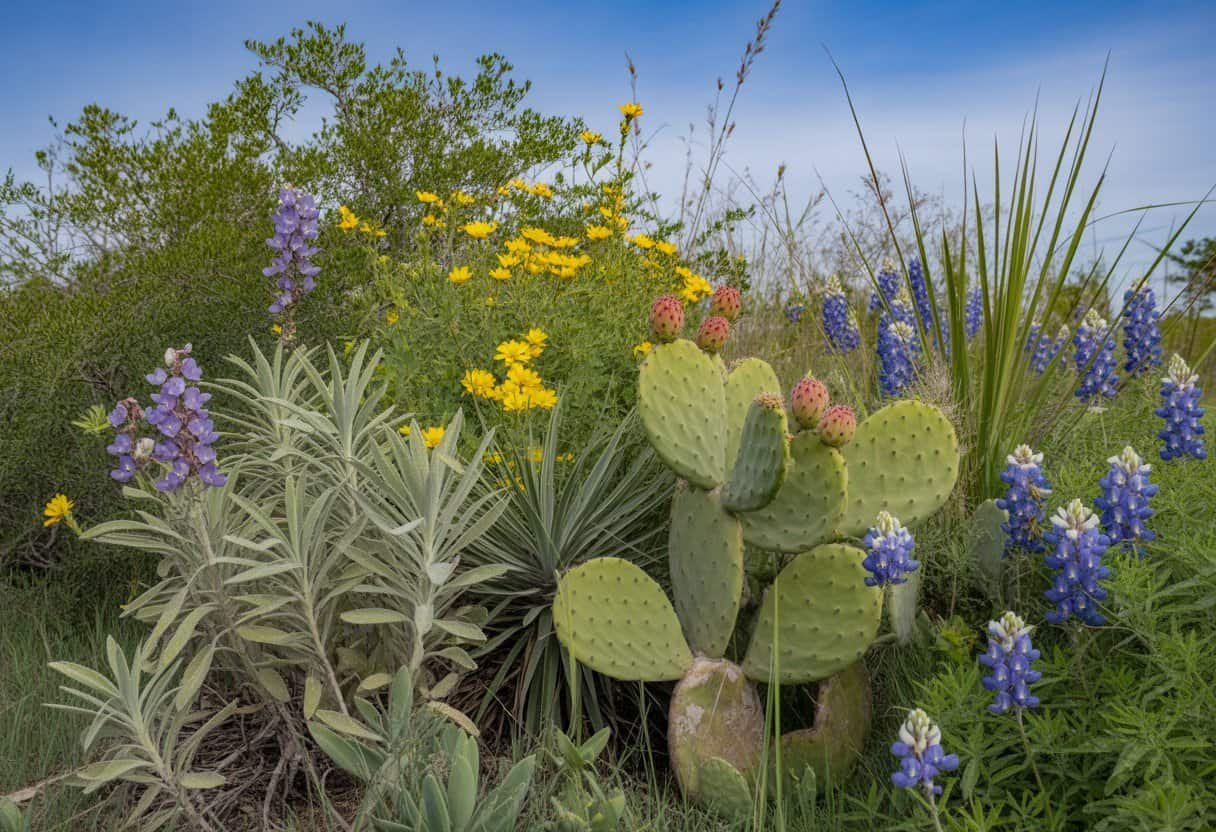
Native plants connect us to Austin’s natural heritage and help preserve our regional identity. From the vibrant blooms of blackfoot daisy to the elegant structure of Texas sage, these plants offer something for every garden style.
They’re perfectly suited to our hot summers, occasional freezes, and varying rainfall patterns.
Key Takeaways
- Native plants require less water, fertilizer, and maintenance than non-native species once established in Austin gardens.
- Austin’s native plant species support local pollinators and wildlife that depend on these plants for food and habitat.
- Adding native plants to your landscape helps preserve Austin’s natural heritage while creating a sustainable, beautiful garden.
What Makes Austin Native Plants Unique
Austin’s native plants have evolved specific traits and adaptations that make them well-suited for the local environment. These plants have developed remarkable strategies to thrive in Central Texas’s unique climate and soil conditions.
Defining Native Plants in the Austin Region
Native plants in Austin are species that existed in Central Texas before European settlement. These include Texas mountain laurel, yaupon holly, and various oak species that have grown naturally in the Hill Country for thousands of years.
Native plants are specifically adapted to Austin’s limestone-rich soils. Unlike imported species, these plants don’t need soil amendments to flourish in the alkaline conditions common throughout the region.
The geographical boundaries for Austin native plants include Travis County and surrounding areas in the Edwards Plateau and Blackland Prairie ecological regions. This unique location at the intersection of different ecosystems creates diverse plant communities.
Many Austin natives have deep historical connections to the area. Indigenous peoples used plants like agarita and yucca for food, medicine, and tools long before the city existed.
Adaptations to Central Texas Climate
Austin native plants have evolved strong drought tolerance. Species like blackfoot daisy and Texas sage can survive the hot summers with minimal water once established.
Deep root systems help plants like Texas persimmon and little bluestem grass access water during dry periods. Many Austin natives have specialized leaves to manage water loss.
Smaller leaves, waxy coatings, and silver or gray coloration help reflect sunlight and reduce evaporation during intense summer heat. These plants can handle temperature extremes from mild winter freezes to 100°F+ summer days.
Native oaks and junipers remain evergreen despite these fluctuations. Seasonal dormancy helps plants like bluebonnets complete their life cycles during spring before summer heat arrives.
Ecological Benefits in Austin Landscapes
Austin native plants create vital wildlife habitat. Cedar elms support over 40 butterfly species, while flame acanthus attracts hummingbirds with its tubular red flowers.
These plants form the foundation of local food webs. Native insects evolved alongside these plants, and birds depend on these insects for food.
Water conservation is a major benefit of native landscapes. Once established, these plants typically require 75-80% less water than non-native alternatives.
Native plants help manage stormwater by increasing soil absorption. Their extensive root systems prevent erosion on Austin’s hilly terrain.
Best Native Plants for Austin Gardens
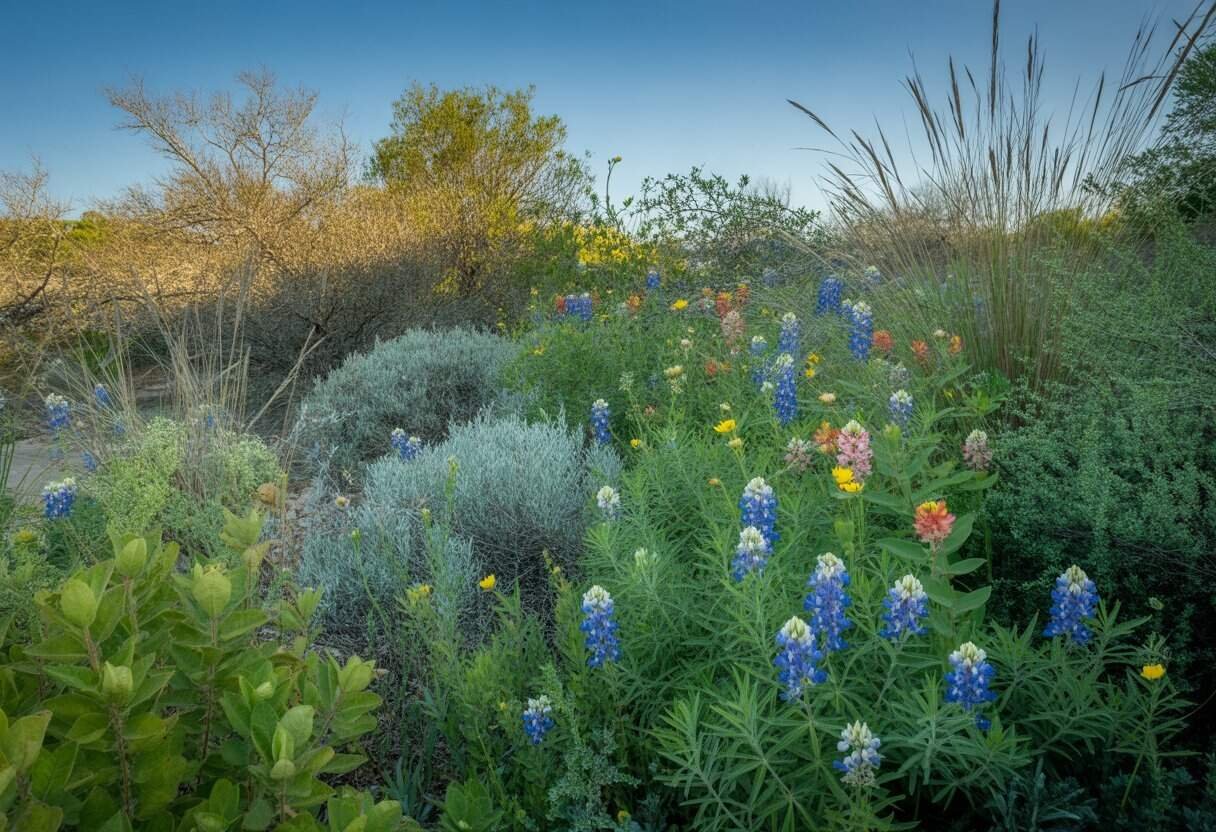
Austin gardens thrive with native plants that have adapted to the region’s climate and soil conditions. These plants require less water and maintenance, and they provide essential habitat for local wildlife.
Top Perennial Flowers and Wildflowers
Blackfoot Daisy offers white flowers with yellow centers that bloom most of the year. This drought-tolerant perennial grows 12-18 inches tall and spreads nicely in sunny spots.
Texas Lantana produces clusters of orange, yellow, and red flowers that attract butterflies from spring until frost. It handles heat and drought with ease, making it perfect for Austin yards.
Purple Coneflower (Echinacea) features distinctive purple-pink flowers with raised centers. This hardy wildflower blooms from May through October and reaches 2-3 feet tall.
Mealy Blue Sage displays spikes of blue-purple flowers above silvery-green foliage. This perennial blooms heavily in spring and fall, with sporadic flowers during summer heat.
Gregg’s Mistflower creates clouds of blue-purple flowers in fall that attract monarch butterflies. It spreads easily and works well as a ground cover in partial shade.
Recommended Native Grasses and Ground Covers
Little Bluestem stands out as a beautiful ornamental grass that changes from blue-green in summer to rusty-orange in fall. It grows in clumps 2-4 feet tall and provides winter interest in Austin gardens.
Texas Sedge forms low, fine-textured mounds that substitute perfectly for traditional lawn grass. This 4-6 inch ground cover requires minimal water and no mowing.
Horseherb creates a dense carpet of small, heart-shaped leaves with tiny yellow flowers. It tolerates shade and moderate foot traffic, making it ideal for areas between stepping stones.
Frogfruit spreads quickly to form a drought-tolerant ground cover with small white flowers that attract butterflies. It can handle some foot traffic and stays under 6 inches tall.
Big Muhly develops airy, pink-purple seed heads in fall that catch morning light beautifully. This 3-5 foot grass provides movement and texture in Austin landscapes.
Favorite Native Shrubs and Small Trees
Texas Sage (Cenizo) features silvery-gray foliage and purple flowers that bloom after rain. This 4-8 foot shrub thrives in full sun and poor soil conditions common in Austin.
Agarita offers spiny, blue-green foliage with fragrant yellow flowers in early spring. Birds love its bright red berries, and the 3-6 foot shrub requires almost no maintenance.
Yaupon Holly grows as either a small tree or large shrub with bright red berries that persist through winter. Female plants produce berries that attract birds to Austin yards.
Texas Mountain Laurel develops clusters of purple, grape-scented flowers in spring. This slow-growing small tree reaches 15 feet and maintains an evergreen presence year-round.
Possumhaw Holly loses its leaves in winter to showcase spectacular red berries on bare branches. This small tree grows 15-20 feet tall and provides excellent wildlife value.
Types of Native Plants for Austin
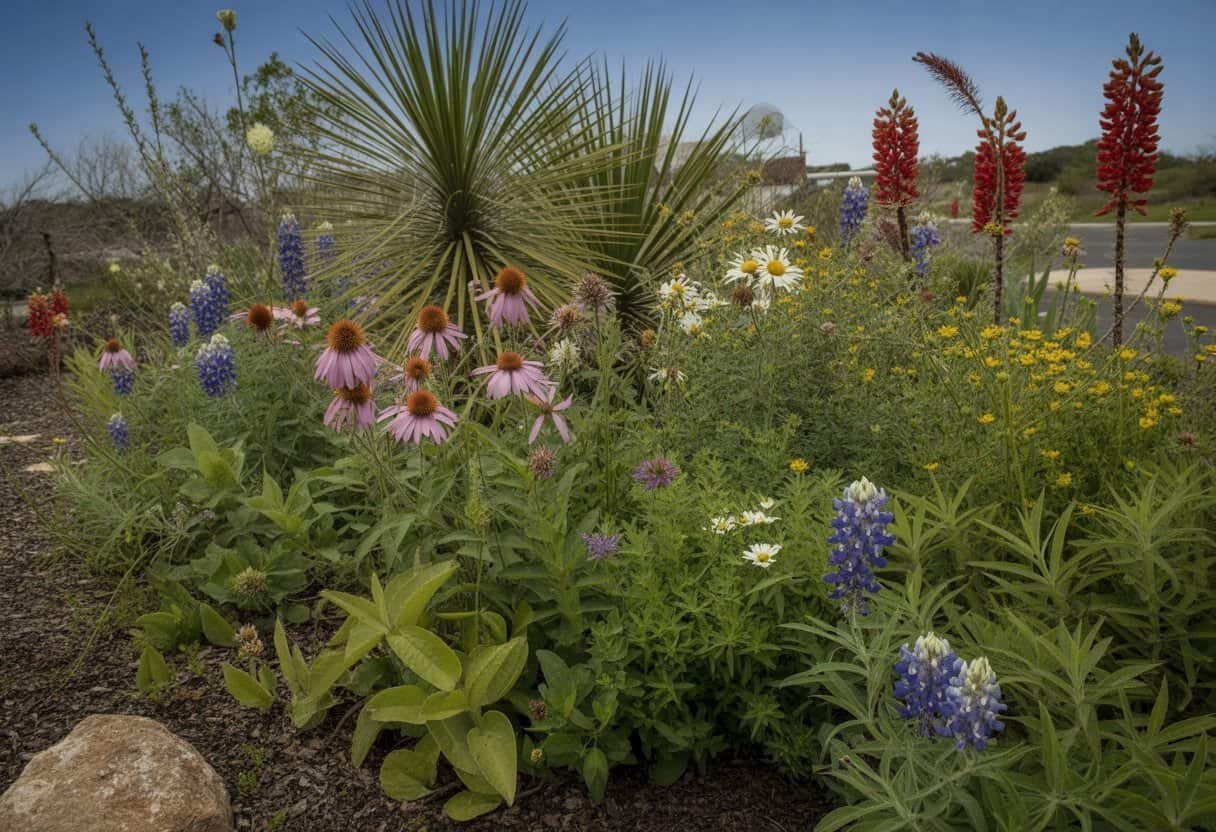
Austin’s unique climate supports a diverse range of native plants that thrive in Central Texas conditions. These plants have adapted to local soil types, rainfall patterns, and temperature fluctuations.
Drought-Tolerant and Xeriscape Options
Blackfoot Daisy offers white flowers that bloom most of the year and requires minimal water. This tough plant grows about 12 inches tall and spreads beautifully in well-drained soil.
Texas Sage (Cenizo) displays stunning silver-gray foliage and purple blooms after rain. It’s perfect for xeriscaping and requires almost no maintenance once established.
Mexican Feathergrass creates elegant movement in gardens with its fine-textured leaves. It thrives in full sun and well-drained soils, reaching 2-3 feet tall.
Top Drought-Tolerant Plants for Austin:
- Mealy Blue Sage
- Four-nerve Daisy
- Flame Acanthus
- Texas Mountain Laurel
- Autumn Sage
These plants save water while providing color and texture throughout the seasons.
Shade-Loving and Sun-Loving Varieties
Cedar Sage thrives in partial shade under trees. Its bright red flowers attract hummingbirds from spring through fall.
This adaptable plant reaches about 2 feet tall. Turk’s Cap grows well in varying light conditions from deep shade to partial sun.
Its unusual red flowers resemble small turbans and bloom summer through fall. For full sun areas, Mexican Honeysuckle offers orange tubular flowers that pollinators love.
It grows 3-4 feet tall and handles heat exceptionally well.
Light Requirements for Native Plants:
| Plant Name | Shade Tolerance | Sun Tolerance |
|---|---|---|
| Inland Sea Oats | High | Low |
| Texas Lantana | Low | High |
| American Beautyberry | Medium | Medium |
| Gregg’s Mistflower | Medium | High |
Choose plants based on your specific yard conditions for best results.
Succulents, Yuccas, and Cacti
Texas Sotol features a dramatic rosette of slender blue-green leaves. This striking succulent sends up an impressive 10-foot flower stalk when mature.
Twisted-Leaf Yucca requires minimal water and maintenance. Its distinctive spiral leaves create year-round interest in the landscape.
Prickly Pear Cactus offers beautiful yellow flowers in spring followed by edible fruits. Different varieties provide various sizes and spine configurations.
Planting Tips for Succulents:
- Use extremely well-drained soil
- Plant in raised beds or on slopes when possible
- Water deeply but infrequently
- Avoid planting in areas with poor drainage
These hardy plants thrive in Austin’s hot summers and occasional freezes. They create dramatic focal points in the landscape.
Supporting Local Wildlife and Pollinators
Native plants play a vital role in sustaining Austin’s local ecosystem. They provide essential food sources and habitat for wildlife that has evolved alongside these plants for thousands of years.
Attracting Bees, Butterflies, and Birds
Austin’s native plants offer perfect food sources for local pollinators. Bright blooms like Texas lantana and purple coneflower produce abundant nectar that attracts honeybees and native bee species.
Butterflies flock to plants such as:
- Gregg’s mistflower
- Turk’s cap
- Flame acanthus
- Antelope horns milkweed
Milkweed varieties serve as the only host plants for monarch butterfly larvae. These iconic butterflies migrate through Central Texas and depend on milkweed for reproduction.
Birds benefit from native plants too. Cardinal flower attracts hummingbirds with its bright red tubular blooms.
Plants like American beautyberry produce berries that provide essential nutrition for mockingbirds, cardinals, and other local bird species.
Creating Habitat with Native Plants
Native plants form the foundation of functional wildlife habitats in Austin landscapes. These plants have adapted to local conditions and require minimal maintenance once established.
Creating layers in your garden mimics natural ecosystems. Tall trees like live oaks provide nesting sites, while understory plants offer shelter and food sources.
Leave some areas unmulched and undisturbed so ground-nesting bees can access soil. Fallen leaves provide shelter for beneficial insects and decomposers.
Water features enhance wildlife habitat value. Even a small birdbath or shallow dish provides drinking water for pollinators and birds during hot Texas summers.
Native grasses like little bluestem and Indiangrass offer shelter for small mammals and nesting material for birds. Their seed heads provide winter food sources when other options are scarce.
Iconic Austin Native Plant Species
Austin’s landscape is defined by a diverse array of native plants that have adapted to the region’s unique climate and soil conditions. These plants create the distinctive character of the Texas Hill Country and provide essential habitat for local wildlife.
Trees: Oaks, Desert Willow, Lacey Oak
Live oak trees dominate Austin’s landscape with sprawling canopies and evergreen foliage. These trees can live for centuries and provide vital shade in hot summer months.
Lacey oak is a medium-sized deciduous tree that reaches 25-35 feet tall. Its blue-gray leaves turn copper in fall, adding seasonal color to gardens.
This drought-tolerant tree thrives in Austin’s limestone soils.
Desert willow isn’t a true willow but earns its name from its slender, willow-like leaves. This small tree produces trumpet-shaped flowers in shades of pink, purple, and white from spring through fall.
Hummingbirds and native bees often visit its nectar-rich blooms.
Shrubs: Flameleaf Sumac, Texas Sage, Rock Rose
Flameleaf sumac creates autumn displays with foliage turning bright red and orange. This native shrub grows 10-15 feet tall and produces red berries that feed local birds through winter.
Texas sage (cenizo or Texas silverleaf) features silvery-gray foliage and produces purple flowers after summer rains. This drought-resistant shrub thrives in full sun and poor soils.
Rock rose (Pavonia lasiopetala) blooms from spring through fall with bright pink flowers. This compact shrub grows 2-3 feet tall and attracts butterflies.
It pairs well with evergreen sumac and roughleaf dogwood in natural garden settings.
Wildflowers and Grasses: Blue Mistflower, Little Bluestem, Prairie Verbena
Blue mistflower creates blue-purple blooms in fall, attracting butterflies. This spreading perennial works well in garden borders or naturalized areas.
Little bluestem (Schizachyrium scoparium) is a native grass that turns reddish-bronze in fall. It grows in upright clumps 2-4 feet tall and provides seeds for birds.
Prairie verbena covers the ground with purple flower clusters from spring through fall. This low-growing perennial forms colorful mats in sunny areas.
Black-eyed Susan, winecup, and Texas red yucca add to Austin’s wildflower palette. Missouri primrose offers yellow blooms, while Wright’s purple skullcap and Hill Country penstemon add blues and purples to the landscape.
Austin’s Native Plant Ecosystems and Regions
Austin sits at the intersection of three distinct ecological regions. Each region has unique plant communities shaped by soil, rainfall, and geological history.
These natural areas support diverse native plants adapted to local conditions over thousands of years.
Edwards Plateau: Plants and Habitat
The Edwards Plateau, or Hill Country, forms Austin’s western edge with thin, limestone-based soils and rugged terrain. This region receives about 30-35 inches of rainfall annually, creating a semi-arid environment.
Native trees like Ashe juniper, Texas oak, and live oak dominate the landscape. Understory plants include Texas mountain laurel, agarita, and twist-leaf yucca, all adapted to alkaline soils.
Springs and creeks support water-loving species such as cypress trees and maidenhair ferns. In spring, wildflowers like bluebonnets, Indian paintbrush, and pink evening primrose create colorful displays.
Wildlife depends on these plant communities for food and shelter. The golden-cheeked warbler, an endangered bird, needs mature Ashe juniper trees for nesting materials.
Blackland Prairie: Plant Adaptations
The Blackland Prairie covers Austin’s eastern side with deep, dark clay soils formed from ancient marine deposits. Before settlement, this region was mostly tallgrass prairie with few trees.
Native grasses like little bluestem, Indian grass, and switchgrass have root systems reaching 8-15 feet deep. These roots help plants survive droughts and prairie fires while building the rich soil.
Wildflowers including Mexican hat, black-eyed Susan, and gayfeather add seasonal color. These plants evolved with periodic fires and grazing by bison, which helped maintain the prairie ecosystem.
Today, less than 1% of the original Blackland Prairie remains in Texas. Conservation efforts focus on preserving and restoring these grasslands.
Post Oak Savannah: Distinctive Flora
The Post Oak Savannah transitions between the Blackland Prairie and the East Texas Piney Woods. This region features sandy loam soils with scattered trees amid grassland areas.
Post oak trees define this ecosystem, growing in loose clusters with blackjack oak and cedar elm. These drought-resistant trees survive in the area’s sandy, acidic soils.
The savannah’s understory includes yaupon holly, American beautyberry, and little bluestem grass. Seasonal wildflowers like coreopsis, winecup, and prairie verbena thrive in partial shade.
Local lakes and streams support water-tolerant plants including buttonbush, black willow, and sycamore trees along their banks. These riparian areas create wildlife corridors throughout the region.
Landscaping and Garden Design with Austin Native Plants
Native plants offer practical and beautiful landscaping solutions for Austin gardens. They need less water and maintenance while providing habitat for local wildlife.
Low Maintenance Strategies
Native plants reduce garden maintenance once established. They usually need watering only during extreme drought, unlike non-native species that often require regular irrigation.
This water efficiency comes from their deep root systems developed in Central Texas conditions. Many Austin natives like Texas sage, flame acanthus, and Gregg’s mistflower rarely need pruning.
They naturally grow to appropriate sizes for their environments. These plants also resist local pests and diseases, so gardeners rarely need chemical treatments.
Group plants with similar water needs together in zones. This practice, called hydrozoning, ensures efficient water use.
Consider mature plant size when designing to avoid extra pruning and maintenance later.
Soil, Mulch, and Organic Matter
Austin’s soil varies from thin limestone in western areas to deeper clay in eastern parts. Native plants thrive in their respective soil types without amendments.
Adding compost can improve soil structure and drainage. Mulch plays a crucial role in native gardens.
Apply a 2-3 inch layer of native hardwood mulch around plants to reduce soil temperature, conserve moisture, suppress weeds, and add organic matter as it breaks down.
Avoid piling mulch against plant stems to prevent rot. Refresh mulch annually in spring as it decomposes.
Leaf litter serves as natural organic matter. Leaving fallen leaves to decompose mimics forest floor processes and returns nutrients to the soil while providing habitat for beneficial insects.
Coping with Flash Floods and Drainage
Austin’s climate brings both drought and sudden heavy downpours. Design gardens to capture and filter rainwater with rain gardens and swales.
Plant water-tolerant natives like eastern gamagrass and cardinal flower in these areas to help manage flash floods.
Permeable hardscaping materials let water soak into the ground instead of running off. Use decomposed granite pathways, gravel, or spaced pavers instead of concrete.
Place boulders and rock berms to direct water flow away from structures and prevent erosion during heavy rains. Position them perpendicular to water flow on slopes.
Native plants with deep roots like switchgrass and little bluestem stabilize soil during heavy rain events. Their roots create channels for water to penetrate deeper into the soil.
Where to Find and Learn About Native Plants in Austin
Austin offers many resources for those interested in native plants. These include specialized nurseries, educational materials, and community events.
Local Nurseries and Suppliers
Several Austin nurseries specialize in native plants. Barton Springs Nursery on Bee Cave Road carries a wide selection of Texas natives and provides knowledgeable staff.
The Natural Gardener on Old Bee Cave Road offers plants and demonstration gardens to show natives in landscape settings.
Leaf Landscape Supply has two Austin locations and stocks many drought-tolerant natives. For rare species, Lady Bird Johnson Wildflower Center’s plant sales offer hard-to-find varieties.
Many nurseries offer:
- Free gardening classes
- Soil testing services
- Native plant guides for Austin’s climate
- Expert advice on plant placement and care
Texas Parks and Wildlife Resources
Texas Parks and Wildlife Department (TPWD) provides resources for native plant enthusiasts. Their website features plant guides tailored to different Texas ecoregions, including areas around Austin.
TPWD’s Texas Wildscapes program offers certification for yards that support wildlife through native plantings. They publish free guides with plant lists for Austin’s growing conditions.
The department maintains demonstration gardens at parks near Austin, including McKinney Falls State Park. These showcase native plants in natural settings.
TPWD also offers workshops on topics like:
- Creating pollinator gardens with natives
- Water conservation through plant selection
- Identifying invasive species
Community Events and Plant Sales
Austin’s community celebrates native plants through various events. The Lady Bird Johnson Wildflower Center hosts plant sales in spring and fall, featuring hundreds of species.
Austin’s Native Plant Society chapter organizes monthly meetings with expert speakers and field trips to natural areas. Their annual symposium brings together native plant experts from across Texas.
The Travis County Master Gardeners hold plant sales and free gardening seminars focused on sustainable landscaping with natives. Their demonstration garden at the AgriLife Extension office showcases Texas plants in real garden settings.
Zilker Botanical Garden features native plant areas and hosts the annual Garden Festival focusing on plants suited to Austin’s climate.
Frequently Asked Questions
Austin gardeners often have questions about using native plants in their landscapes. Native plants offer benefits like water conservation, wildlife support, and reduced maintenance.
What are some low maintenance native plants recommended for Austin landscaping?
Several Austin native plants require minimal care once established. Texas sage thrives in full sun with almost no supplemental water.
Gregg’s mistflower attracts butterflies and needs only occasional watering during extreme drought. It spreads nicely without becoming invasive.
Blackfoot daisy forms low mounds of white flowers that bloom most of the year with little attention.
Muhly grass and other native grasses need cutting back just once a year and provide movement and texture in the landscape.
How can I identify native plants specific to the Austin region?
The Lady Bird Johnson Wildflower Center offers resources for identifying Austin native plants. Their website features searchable databases with photos and growing information.
Field guides for Central Texas plants help with identification during hikes and nature walks. Look for books by local authors familiar with Austin ecology.
Native plant nurseries label their stock clearly, and staff can help with identification. Many provide information cards with photos of the mature plant.
Can you list native shrubs that thrive in the Austin climate?
Agarita features spiny leaves and bright yellow flowers followed by red berries. It reaches 3-5 feet tall and thrives in sun or part shade.
Evergreen sumac produces clusters of red berries loved by birds. This drought-tolerant shrub grows 6-8 feet tall.
Yaupon holly adapts to various light conditions and soil types. Its red berries persist through winter, providing food for wildlife.
Texas mountain laurel offers fragrant purple flowers in spring. This slow-growing evergreen eventually reaches 15 feet tall.
What are the best flower species native to Austin for a vibrant garden?
Black-eyed Susan produces bright yellow flowers from late spring through fall. These blooms attract butterflies and other pollinators.
Prairie verbena forms a low carpet of purple flowers nearly year-round. It reseeds readily but isn’t aggressive.
Standing cypress sends up dramatic 3-foot spikes of tubular red-orange flowers that hummingbirds love. This biennial reseeds reliably.
Mealy blue sage blooms for months with spikes of blue flowers. It handles both drought and occasional flooding.
What Central Texas native plants could be used effectively for home landscaping?
Texas persimmon offers attractive peeling bark and small edible fruits. This small tree works well as a focal point in yards with limited space.
Flame acanthus produces red-orange tubular flowers that attract hummingbirds and butterflies. This woody perennial reaches about 3 feet tall.
Gulf muhly grass creates pink plumes in fall. Plant it where backlight from the setting sun will illuminate its seed heads.
Cedar sage thrives in the dappled shade under live oaks. Its bright red flowers appear in spring, bringing color to shady spots.
Where can I find a guide to native plants suitable for the environmental conditions of Austin?
The City of Austin Watershed Protection Department offers free guides to native plants suited for local conditions. These guides include plant lists organized by sun exposure and water needs.
The Travis County Extension Office provides fact sheets about native landscaping in Austin. Their materials describe soil types in different parts of the city.
Local bookstores carry gardening books focused on Central Texas natives. Books by Sally Wasowski and Jill Nokes can help Austin gardeners.

